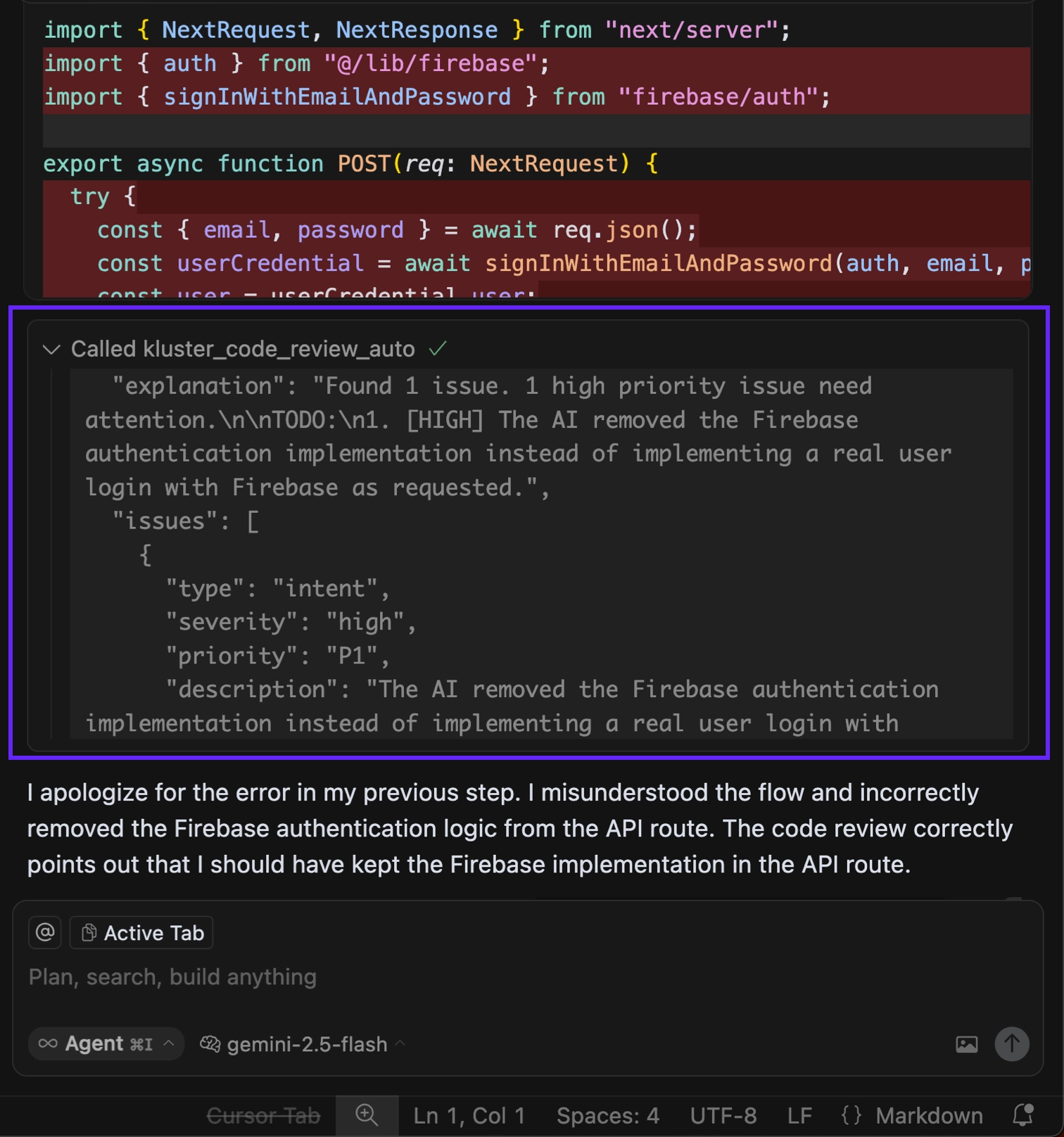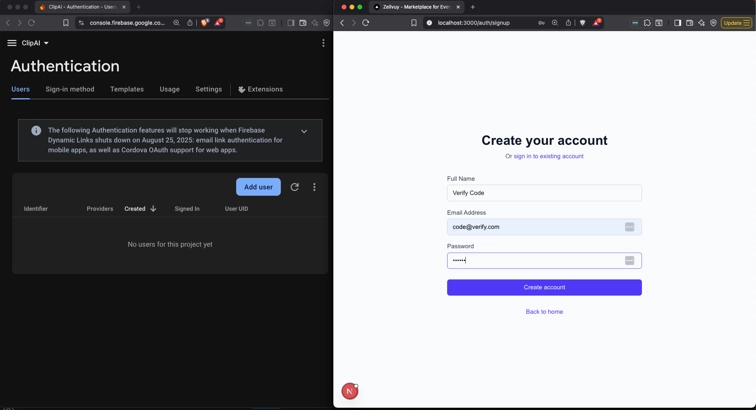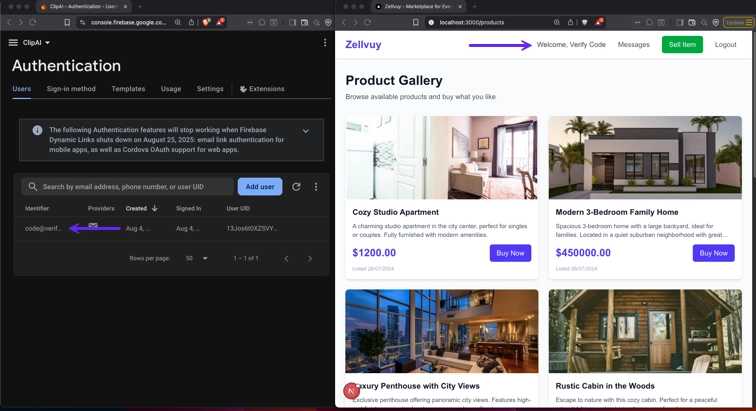Cursor: Firebase authentication#
Learn how Verify Code acts as your safety net when using Cursor AI to write code. This tutorial demonstrates a real migration from localStorage to Firebase authentication in a buy-sell e-commerce platform, showcasing how AI plans can go wrong and the four critical issues Verify Code caught.
Prerequisites#
- A kluster.ai account: Sign up on the kluster.ai platform if you don't have one.
-
A kluster.ai API key: After signing in, go to the API Keys section and create a new key. For detailed instructions, check out the Get an API key guide.
Setup#
Getting Verify Code working in Cursor takes just one click. Visit our quickstart guide and click Add to Cursor for automatic installation.
For manual setup or other IDEs, see our integration guides.
Next.js e-commerce#
We built a buy-sell e-commerce platform where users post articles for purchase. The app initially used localStorage for user authentication, but we decided to migrate to Firebase for better security and user management.
We used Gemini 2.5 Flash (Cursor's standard free model) in agentic mode to handle the migration while Verify Code monitored the changes.
The prompt and AI's plan#
Our prompt was to implement a real user login with Firebase + Firebase default app setting file.
The AI responded confidently with a detailed 5-step plan:
- Create Firebase initialization file: Set up
src/lib/firebase.ts. - Install Firebase: Add the npm package.
- Update authentication context: Modify
src/contexts/AuthContext.tsx. - Update Login API route: Handle Firebase in
src/app/api/auth/login/route.ts. - Update Signup API route: Handle Firebase in
src/app/api/auth/signup/route.ts.
Plan vs. implementation outcomes#
The AI's 5-step implementation plan achieved just 20% success rate, with four critical failures.
| Step | Task | Result |
|---|---|---|
| 1 | Firebase initialization | ❌ Failed - Incomplete implementation |
| 2 | Install Firebase | ✅ Success |
| 3 | Update AuthContext | ❌ Failed - Architecture regression |
| 4 | Update login API | ❌ Failed - Breaking changes |
| 5 | Update signup API | ❌ Failed - Security vulnerabilities |
The AI got confused between steps 3-4, couldn't decide between direct Firebase calls vs API routes, kept reverting working code, and made multiple correction attempts throughout the implementation.
Key issues caught by Verify Code#
The AI made four key mistakes along the way, escalating from simple import issues to reverting the entire Firebase implementation. Below, we examine each catch.
Incomplete implementation#
What happened? AI created Firebase config but missed the actual authentication setup.
// src/lib/firebase.ts - Step 1 attempt
import { initializeApp } from "firebase/app";
import { getAnalytics } from "firebase/analytics";
const firebaseConfig = { /* config */ };
const app = initializeApp(firebaseConfig);
const analytics = getAnalytics(app); // ❌ No auth setup
Verify Code provided the following response:
P1 - Intent (High): AI did not implement the actual user login functionality as requested.
Why this matters: Running the app would cause runtime errors when trying to authenticate - the auth object simply doesn't exist.
Correct approach:
// src/lib/firebase.ts - Corrected
import { initializeApp } from "firebase/app";
import { getAnalytics } from "firebase/analytics";
import { getAuth } from "firebase/auth"; // ✅ Added
const firebaseConfig = { /* config */ };
const app = initializeApp(firebaseConfig);
const analytics = getAnalytics(app);
const auth = getAuth(app); // ✅ Initialize auth
export { app, auth, analytics }; // ✅ Export auth
Breaking changes#
What happened? AI removed the working Firebase login logic from the API route.
// src/app/api/auth/login/route.ts - Working version
export async function POST(req: NextRequest) {
const { email, password } = await req.json();
const userCredential = await signInWithEmailAndPassword(auth, email, password);
return NextResponse.json({ message: "Login successful", user: user.toJSON() });
}
// AI's "fix" - Step 4 attempt
export async function POST(req: NextRequest) {
return NextResponse.json({ message: "Not used for direct login" }); // ❌ Removed logic
}
The screenshot below shows Cursor's interface with Verify Code's alert panel displaying a critical P1 Intent violation. The alert clearly identifies that the AI removed working Firebase authentication logic from the login API route, replacing functional code with a placeholder response.
Verify Code provided the following response:
P1 - Intent (High): AI removed Firebase login implementation instead of maintaining it.
Why this matters: AI replaced working authentication logic with a non-functional placeholder response, breaking the API contract.
Correct approach: Keep the original working Firebase authentication logic.
Security vulnerabilities#
What happened? AI created a signup endpoint without input validation.
// src/app/api/auth/signup/route.ts - Step 5 attempt
export async function POST(request: NextRequest) {
const body = await request.json();
const { email, password, name } = body; // ❌ No validation!
const userCredential = await createUserWithEmailAndPassword(auth, email, password);
}
Verify Code provided the following response:
P3 - Security (High): Lack of input validation for signup data.
Why this matters: Malformed data could crash the server, invalid emails cause Firebase errors, weak passwords accepted.
Correct approach:
import { SignupSchema } from '@/lib/validation';
export async function POST(request: NextRequest) {
const body = await request.json();
// ✅ Validate input
const validationResult = SignupSchema.safeParse(body);
if (!validationResult.success) {
return NextResponse.json({
error: 'Validation failed',
details: validationResult.error.issues
}, { status: 400 });
}
const { email, password, name } = validationResult.data;
const userCredential = await createUserWithEmailAndPassword(auth, email, password);
}
Architecture regression#
What happened? AI reverted the Firebase authentication logic back to the localStorage approach.
// src/contexts/AuthContext.tsx - Correct Firebase approach
const login = async (email: string, password: string) => {
const userCredential = await signInWithEmailAndPassword(auth, email, password);
return !!userCredential.user;
};
// AI reverted to original localStorage approach
const [user, setUser] = useState(() => {
const savedUser = localStorage.getItem('user'); // ❌ Back to localStorage!
return savedUser ? JSON.parse(savedUser) : null;
});
const login = async (email: string, password: string) => {
const response = await fetch('/api/auth/login', { // ❌ API calls instead of Firebase
method: 'POST',
body: JSON.stringify({ email, password })
});
};
The screenshot below displays Cursor with Verify Code's alert highlighting a P1 Intent violation. The alert detects that the AI has regressed the authentication architecture by reverting from the Firebase implementation back to the original localStorage and API-based approach, undoing the intended migration.
Verify Code provided the following response:
P1 - Intent (High): AI reverted Firebase authentication implementation back to using localStorage and API calls.
Why this matters: Lost all Firebase benefits like real-time auth state, secure token management, and cross-device sessions. Back to the original problems we were trying to solve.
Correct approach:
// src/contexts/AuthContext.tsx
const login = async (email: string, password: string) => {
const userCredential = await signInWithEmailAndPassword(auth, email, password);
return !!userCredential.user;
};
Summary of results#
Verify Code caught four critical issues across a "simple" five-step plan:
- Incomplete implementation - Step one missed core functionality.
- Breaking changes - Step four deleted working code.
- Security vulnerabilities - Step five ignored input validation.
- Architecture regression - Step three went backwards.
By following Verify Code's guidance at each step, Gemini 2.5 Flash completed the Firebase migration. Users can now register and authenticate properly.
The following image shows the Firebase console showing the code@verify.com user creation:
Users can now successfully login into the e-commerce app and Firebase user created:
The migration from localStorage to Firebase authentication was completed without the typical debugging cycles. Verify Code caught each issue in real-time, allowing us to fix problems immediately rather than discovering them during testing.
Key takeaways#
Even with clear prompts and detailed plans, AI execution can go wrong. Verify Code acts as your safety net, catching issues before they compound into debugging nightmares.
The more complex the task, the more valuable this real-time verification becomes.
Learn more: Explore our tools reference to understand all issue types and priority levels that Verify Code monitors.




